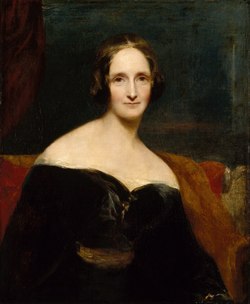
Mary Shelley Page 11
We found 21 free papers on Mary Shelley
Essay Examples
Overview
Frankenstein Romanticism Chart
Frankenstein
Romanticism
A deepened appreciation of the beauties of nature. When Frankincense was dealing with the stress of the creature killing his family members, he found comfort in appreciating nature in solitude. A general exaltation of emotion over reason and of the senses over intellect. After Frankincense dies, the Creature is remorseful. He says that he let…
Frankenstein and King Lear
Books
Frankenstein
King Lear
Literature
The nature of man is often dichotomized into good and evil; where one cannot exist without the other. In the following essay the nature of man according to the definition of evil will be explored in the classic works King Lear and Frankenstein. While the former deals with a man whose evil nature betrays…
The Kraken: an analysis
Monster
Myth
Poetry
Introduction – The collection of poetry that the world has seen is storage of the creations of the different states and stages of a man’s mind, and there are times when the poem captures and freezes the myths and its leading man so that the world has a way of remembering some of the…
Abuse of Power in Heart of Darkness and in Frankenstein
Fiction
Frankenstein
Heart Of Darkness
History
Literature
Monster
Narration
Novel
Victor Frankenstein
How is the abuse of power shown in the two works that you have studied? The works I have studied and will be exploring in this essay are Mary Shelly’s ‘Frankenstein’ and Joseph Conrad’s ‘Heart of Darkness’. In ‘Frankenstein’ the abuse of power is most clearly exhibited by the protagonist of the story Frankenstein himself,…
| born | August 30, 1797, Somers Town, London, United Kingdom |
|---|---|
| died | February 1, 1851, Chester Square, London, United Kingdom |
| description | Mary Wollstonecraft Shelley was an English novelist who wrote the Gothic novel Frankenstein; or, The Modern Prometheus, which is considered an early example of science fiction. She also edited and promoted the works of her husband, the Romantic poet and philosopher Percy Bysshe Shelley. |
| children | Percy Florence Shelley, Clara Everina Shelley, William Shelley |
| information | Short biography of Mary ShelleyMary Shelley (1797-1851) is best known for writing Frankenstein, or The Modern Prometheus (1818), which has become one of the world’s most famous horror stories. She was born in London on 30 August 1797. Her mother, Mary Wollstonecraft, was the author of A Vindication of the Rights of Woman and a radical feminist, and she died just 10 days after Mary was born.Mary was brought up by her father, William Godwin, and her half-sister, Fanny Imlay. After attending a number of schools, she ran away to France with a married man, Percy Bysshe Shelley, in 1814 and married him the following year.They had four children, but only one survived to adulthood. The couple settled near Geneva, Switzerland, and in 1816 visited Lord Byron at the Villa Diodati at Lake Geneva, where they read ghost stories and talked about the idea of creating a ‘ghost story’. Mary began writing Frankenstein the following year. The couple left for England in 1818 and Mary completed the novel there. It was published anonymously in 1818, but Mary’s name was soon attached to it, and it was an instant success. The couple were now famous, and they continued to travel and write. Percy Bysshe Shelley died in 1822, aged just 29, and Mary returned to England with her son. She continued to write and publish, and in 1826 she married a widower, Sir Percy Florence Shelley, who was the son of her late husband’s friend, Sir Timothy Shelley.Mary died in 1851, aged 53.FrankensteinFrankenstein, or The Modern Prometheus, is a novel about a scientist, Victor Frankenstein, who creates a monster from dead body parts. The monster is intelligent and can speak, but he is ugly and feared by everyone who sees him.He turns on his creator and, after killing Frankenstein’s brother, his best friend and his wife, he pursues Frankenstein across the Arctic wastes, finally catching up with him and killing him.The novel was first published in 1818, but it has been reprinted many times and has been made into films, stage plays and television programmes. It is still one of the most famous horror stories ever written. General Essay Structure for this Topic
Important informationSpouse: Percy Bysshe Shelley (m. 1816–1822) Place of burial: St Peter’s Church, Bournemouth, United Kingdom Parents: Mary Wollstonecraft, William Godwin Top stories: Mary Wollstonecraft Shelley’s best-known book is Frankenstein; or, The Modern Prometheus ( 18 18, revised 183 1). She wrote several other novels, including Valperga ( 1823), The Last Man ( 1826), The Fortunes of Perkin Warbeck ( 1830), Lodore ( 1835), and Falkner ( 1837), and a travel book, History of a Six Weeks’ Tour ( 1817)., Books and plays: The Last Man 1826, The Original Frankenstein 1823, Mathilda 1959 |

